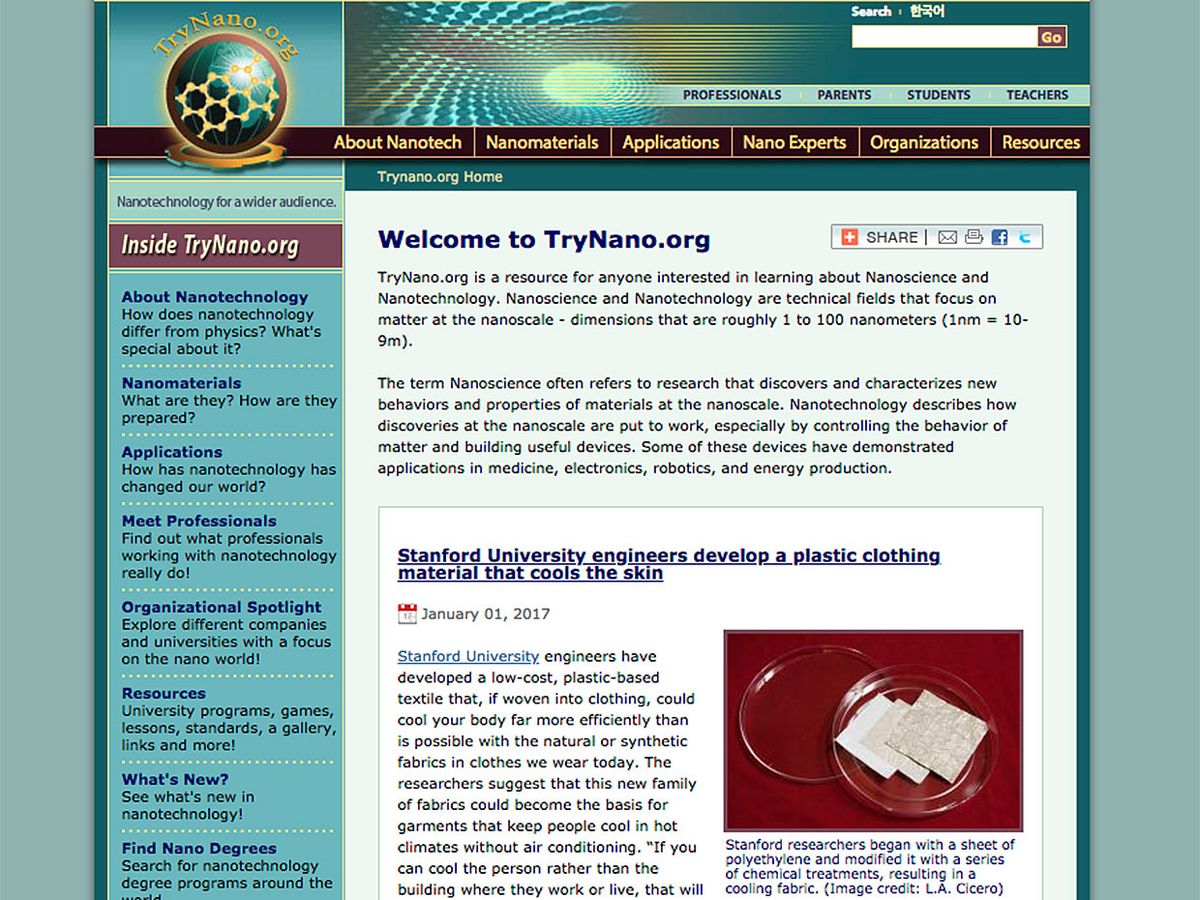THE INSTITUTESometimes working on something small can lead to a big career. That’s true for engineers working in nanotechnology, where new discoveries—and applications for them—are constantly being made, leading to plenty of job opportunities.
Nanoscience and nanotechnology are fields that focus on matter at the nanoscale level—dimensions that are roughly 1 to 100 nanometers (1nm = 10-9 m), as noted on the IEEE-affiliated website TryNano.org. More specifically, the term “nanoscience” refers to research into the behavior and properties of materials at the nanoscale. Applications can be found in medicine, electronics, robotics, energy production, and other fields.
TryNano.org was developed in conjunction with IBM and the New York Hall of Science. It’s aimed at students at all levels, as well as parents, teachers, school counselors, and anyone else wanting to get up to speed on the subject.
It’s the wide range of potential products and applications that gives nanotechnology its enormous job-growth prospects. According to a recent study by market researcher Global Information Inc., the annual worldwide market for products incorporating nanotechnology is expected to reach US $3.3 trillion by 2018. According to the National Nanotechnology Infrastructure Network, the need for technology professionals working in nanotechnology will increase to 1 million employees by 2015.
But the wide range of applications is also indicative of something else: Nanotechnology is not technically an industry in and of itself.
“It’s a great term for creating public interest and for collaborative research,” says Robert D. “Skip” Rung, president and executive officer of the Oregon Nanoscience and Microtechnologies Institute, in Corvallis. “But ‘nanotechnology’ is the new word for chemistry,” he says. Rung is one of the professionals in nanotechnology profiled on TryNano.org.
Nanotechnology, he explains, is where material science has become a molecular-scale discipline. “We can now do things more efficiently and with higher performance by making use of nanoscale scientific principles,” he points out.
One place where such qualities are important is in semiconductors, which currently make up the biggest commercial application of nanotechnology. The technology has enabled advances in computer memory, storage capacity, reduced power consumption, and increased speed. “Semiconductors applications dwarf everything else combined, by a factor of 10,” Rung notes.
MANY PATHS
Where do you go to study nanotechnology? A number of universities offer nanotechnology degrees. But most people in the field get their education in other areas of science such as biochemistry, mechanical engineering, or physics. “There are lots of disciplinary paths that could lead you to a nanoscale job,” Rung says. “It’s a wonderful marriage of everything.”
Although formal education is important, Rung places more value on technical curiosity, the ability to learn new things, and being unafraid to go into areas you don’t know. Communications skills also are valuable, because the interdisciplinary nature of nanoscale work requires people to be able to talk to others in a wide range of fields and understand their often-divergent terminologies and goals.
Donald R. Baer, another expert profiled on TryNano.org, notes that experience with handling the equipment used in nanotechnology is invaluable.
“You need to know the same clean-room technology that’s used in the semiconductor industry,” says Baer, lead scientist for interfacial chemistry and interim chief science officer at the Environmental Molecular Sciences Laboratory at the U.S. Department of Energy’s Pacific Northwest National Laboratory in Richland, Wash. “Contamination and safe handling issues are the same in nano as they are in semiconductors.
“The number of labs working with nanomaterials is growing dramatically,” Baer adds. “They’re looking at all kinds of new nano properties, for applications ranging from catalysts to energy conversion.” He says that will require an increasingly sophisticated workforce prepared to deal with issues such as cleanliness and nanofabrication quality control.
TOOLS ARE HOT
Another growth area is in building the tools to enable nanoscale research and to help companies exploit nanoscale properties and discoveries.
Rung points to FEI, a company in Hillsboro, Ore, that manufactures electron microscopes and related devices. “Its employees are building nanoscale devices that are positioned with nanometer accuracy,” he says. “Making these devices requires an interdisciplinary team covering mechanical engineering, metallurgy, materials science, and software for controlling the machines and making use of the data they generate.”
Rung calls tools the “hot” segment of the nano market, an assessment that Baer agrees with, equating it with the California gold rush of the 19th century. “The people who made the most money during the gold rush were the ones selling the equipment and food and clothing, not the people searching for gold,” he notes.
Because working at nanoscale requires measuring things that have never been measured, the new new tools are vital to the growth of the science and its commercialization.
But the understanding of how to use nano devices is in short supply, too. Rung recommends that students get as much experience with fabrication and measuring equipment as they can, whether it’s from working on research projects, helping out in their professors’ labs, or through internships.
Get hands-on experience with fabrication and measuring equipment, he says: “Learn how to trouble-shoot them and make them perform well. You could end up being the only person on your team who knows how to do this.”
In fact, Baer says, many universities and companies currently do not have the expertise they need to solve all their nanotechnology-related problems. “Almost a specialty role is needed,” he says, noting that the Environmental Molecular Sciences Lab often provides the know-how.
GETTING STARTED
If you don’t have a degree in nanotechnology, how do you end up working in the field? “I recently heard an industry leader say he didn’t hire nanotechnologists. He hired people with important skills and a strong base in a core engineering field,” Baer recounts.
The best path for any career, Rung adds, is to find what you like to do and be good at it. If that happens to involve working on the nanoscale, all the better.
This article was originally published in April 2012.
